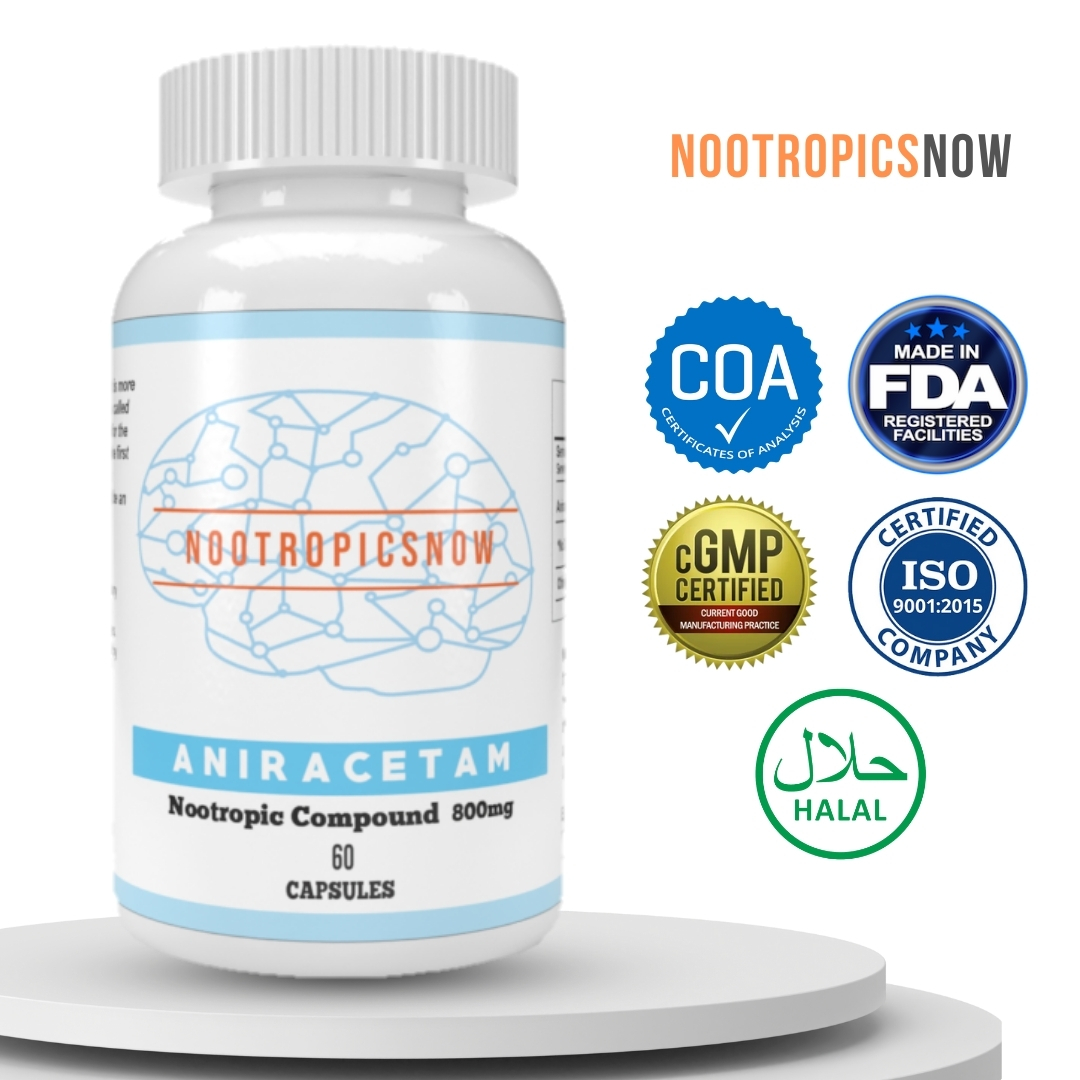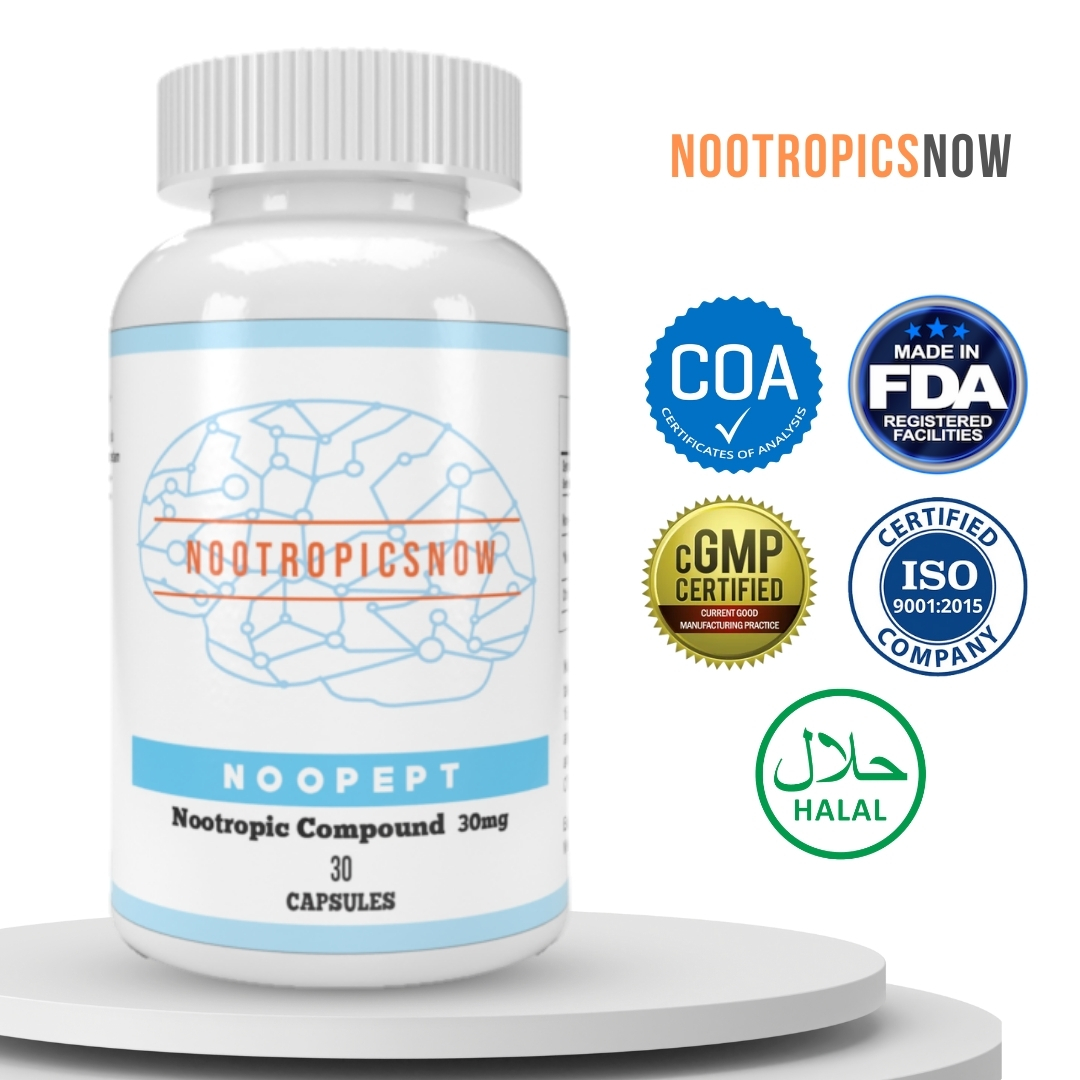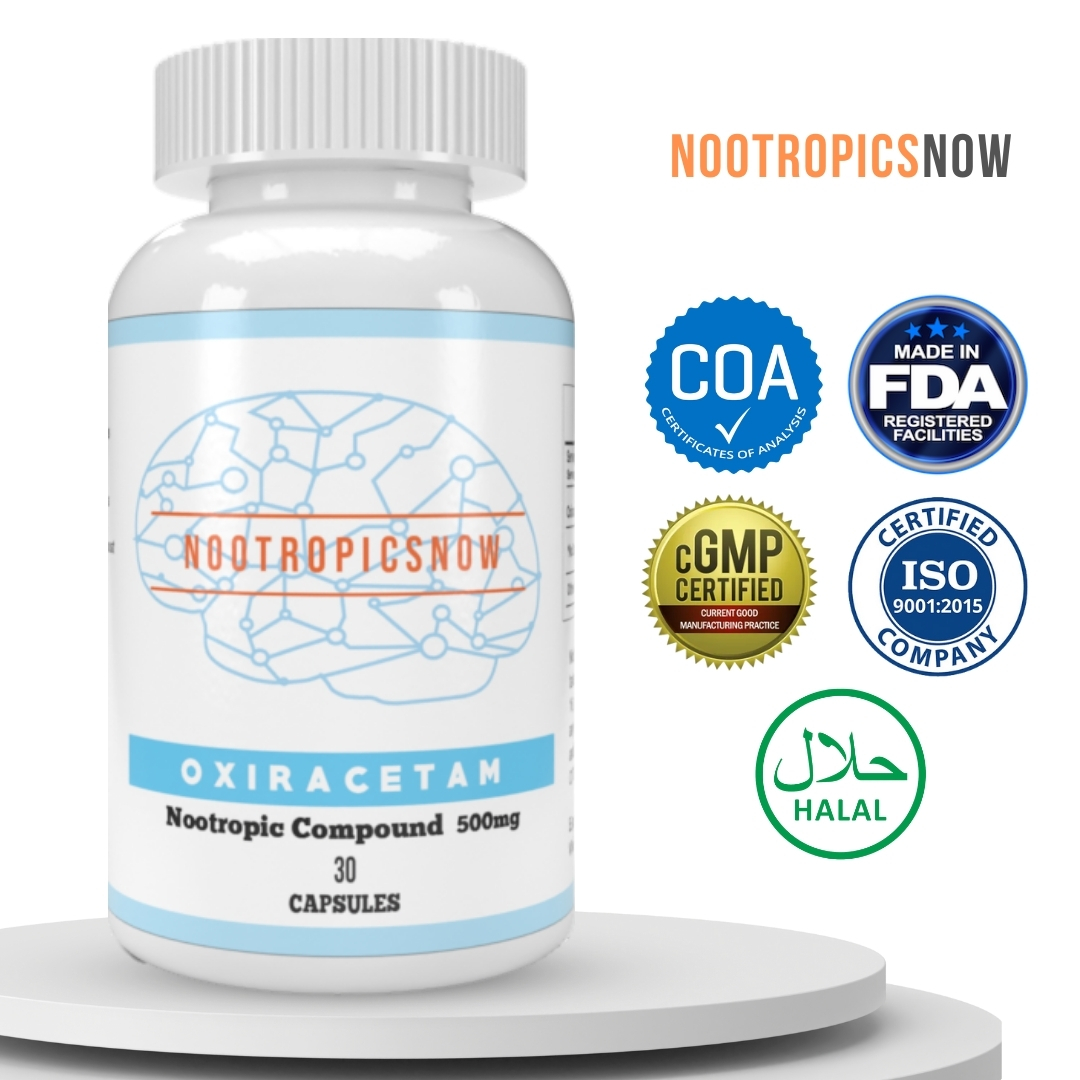Aniracetam: What Is It & How Does It Work?

`markdown
What is Aniracetam? A Comprehensive Guide to Its Benefits, Uses, and Side Effects
Aniracetam, a synthetic nootropic of the racetam family, has garnered attention for its potential cognitive-enhancing properties. Discovered in the 1970s, this compound has been studied for its effects on memory, focus, and overall brain function. This article explores what aniracetam is, how it works, its potential benefits, possible side effects, proper dosage, and legal status. Furthermore, it delves into user experiences and compares aniracetam with other popular nootropics.
Understanding Aniracetam: A Nootropic Overview
Aniracetam is an ampakine nootropic, meaning it primarily affects the AMPA (α-amino-3-hydroxy-5-methyl-4-isoxazolepropionic acid) receptors in the brain. These receptors play a critical role in synaptic plasticity, which is essential for learning and memory. As a derivative of piracetam, aniracetam is considered to be more potent and possesses both anxiolytic (anti-anxiety) and cognitive-enhancing properties.
Chemical Structure and Properties
Aniracetam’s chemical name is 1-p-anisoyl-2-pyrrolidinone. Its molecular formula is C12H13NO3, and it has a molar mass of 219.24 g/mol. It appears as a white to off-white crystalline powder. The compound is fat-soluble, which impacts its absorption and metabolism within the body. Because of this property, it is generally recommended that aniracetam be taken with a source of dietary fat to maximize its bioavailability.
Historical Context
Aniracetam was first synthesized by Hoffmann-La Roche in the 1970s. Since its discovery, it has been the subject of research for various cognitive impairments. In some countries, it is prescribed for conditions such as dementia and cognitive decline. However, its primary use lies in the realm of cognitive enhancement among healthy individuals seeking to improve mental performance.
How Aniracetam Works: The Mechanism of Action
Aniracetam’s mechanism of action is complex and involves several neurotransmitter systems. Although the precise mechanisms are not fully understood, its effects on acetylcholine and glutamate are considered paramount.
Modulation of Acetylcholine
Acetylcholine is a neurotransmitter crucial for memory, learning, and attention. Aniracetam enhances the release of acetylcholine by modulating cholinergic receptors, specifically the muscarinic and nicotinic receptors. By increasing the availability of acetylcholine, aniracetam may improve cognitive functions associated with this neurotransmitter system. Moreover, acetylcholine is crucial for muscle contraction, which can improve physical functions in motor-related issues.
Influence on Glutamate Receptors
Aniracetam primarily affects the AMPA receptors, a subtype of glutamate receptors. Glutamate is the primary excitatory neurotransmitter in the brain, and AMPA receptors play a significant role in synaptic plasticity. Aniracetam increases the efficiency of AMPA receptor transmission, which potentiates synaptic strength and facilitates long-term potentiation (LTP), a cellular mechanism underlying learning and memory.
Interaction with Other Neurotransmitters
While aniracetam’s primary effects are on acetylcholine and glutamate, it also interacts with other neurotransmitter systems, including dopamine and serotonin. These interactions may contribute to its anxiolytic and mood-enhancing properties. However, the exact nature and extent of these interactions require further investigation.
Potential Benefits of Aniracetam: Cognitive and Beyond
Aniracetam is primarily known for its cognitive benefits. However, research suggests it might have other positive effects, including anti-anxiety and neuroprotective properties.
Cognitive Enhancement
The primary reason people use aniracetam is to improve cognitive functions. Studies and user reports suggest the following cognitive enhancements:
Anxiolytic Effects
Aniracetam is often reported to have anxiolytic effects, meaning it can help reduce anxiety and promote a sense of calm. This effect is likely due to its interaction with dopamine and serotonin receptors. This can be particularly beneficial for individuals who experience anxiety alongside cognitive impairments.
Neuroprotective Properties
Research suggests that aniracetam may have neuroprotective properties. It can protect neurons from damage caused by oxidative stress and excitotoxicity. Oxidative stress occurs when there is an imbalance between the production of free radicals and the body’s ability to neutralize them. Excitotoxicity is neuronal damage caused by excessive stimulation of glutamate receptors. By mitigating these processes, aniracetam may help protect against age-related cognitive decline and neurodegenerative diseases.
Potential Applications in Neurological Disorders
While aniracetam is not a primary treatment for neurological disorders, studies suggest it may have potential applications in certain conditions, such as Alzheimer’s disease, stroke, and traumatic brain injury. Its cognitive-enhancing and neuroprotective properties may help improve outcomes in these conditions.
Dosage and Administration: Optimizing for Results
Proper dosage and administration are crucial for achieving the desired effects of aniracetam while minimizing the risk of side effects.
Recommended Dosage
The typical dosage range for aniracetam is 600 to 1500 mg per day, divided into two or three doses. It is generally recommended to start with a lower dose, such as 600 mg per day, and gradually increase it as needed. Some users may find that a higher dose is more effective, while others may experience satisfactory results with a lower dose.
Administration Guidelines
Aniracetam is fat-soluble, which means that it is best absorbed when taken with a source of dietary fat. This can be achieved by taking aniracetam with a meal that contains fats, such as nuts, avocado, or olive oil. Alternatively, it can be taken with a supplement containing healthy fats, such as fish oil or MCT oil.
Timing and Frequency
The effects of aniracetam typically last for 4 to 6 hours, which means that multiple doses may be necessary throughout the day to maintain sustained cognitive benefits. Many users take aniracetam in the morning and again in the afternoon. It is generally not recommended to take aniracetam close to bedtime, as its stimulating effects may interfere with sleep.
Cycling
Some users recommend cycling aniracetam to prevent tolerance and maintain its effectiveness. Cycling involves taking aniracetam for a specific period, followed by a break. A common cycling schedule is to take aniracetam for 2 to 4 weeks, followed by a break of 1 to 2 weeks.
Side Effects and Precautions: What to Watch Out For
While aniracetam is generally well-tolerated, it is important to be aware of potential side effects and take appropriate precautions.
Common Side Effects
The most commonly reported side effects of aniracetam include:
Rare Side Effects
Rare side effects are possible but not frequently observed. These include skin rashes, dizziness, and confusion. If you experience any severe or persistent side effects, discontinue use and consult a healthcare provider.
Precautions and Contraindications
Aniracetam is contraindicated in individuals with known hypersensitivity to the compound. It should be used with caution in individuals with liver or kidney problems, as these conditions may affect its metabolism and excretion.
Aniracetam is also generally not recommended for pregnant or breastfeeding women due to a lack of safety data.
Interactions with Other Drugs
Aniracetam may interact with other drugs, particularly those that affect liver enzymes or blood clotting. It is essential to inform your healthcare provider about all medications and supplements you are taking before starting aniracetam. In particular, caution should be exercised when combining aniracetam with anticoagulants or antiplatelet drugs, as it may increase the risk of bleeding.
Legal Status and Availability: Navigating the Regulations
The legal status of aniracetam varies depending on the country. Understanding the regulations in your region is crucial before purchasing or using this nootropic.
United States
In the United States, aniracetam is not approved as a dietary supplement or medication by the Food and Drug Administration (FDA). However, it is legally available for purchase and use as a research chemical. This means that it can be bought and sold, but it cannot be marketed or sold as a dietary supplement or drug.
Europe
In some European countries, aniracetam is approved as a prescription medication for cognitive disorders, such as dementia and Alzheimer’s disease. It is sold under various brand names, such as Draganon and Ampamet. However, in other European countries, it may be available as an over-the-counter supplement or a research chemical, similar to the situation in the United States.
Canada
In Canada, the legal status of aniracetam is similar to that of the United States. It is not approved as a dietary supplement or medication, but it can be legally purchased and used as a research chemical.
Other Countries
The legal status of aniracetam in other countries varies widely. It is essential to check the specific regulations in your region before purchasing or using this nootropic.
User Experiences and Reviews: Real-World Insights
User experiences and reviews can provide valuable insights into the effects and benefits of aniracetam. Online forums, such as Reddit and Longecity, are popular platforms where users share their experiences with nootropics, including aniracetam.
Positive Experiences
Many users report positive experiences with aniracetam, including improved memory, focus, and mood. Some users also find it helpful for reducing anxiety and improving social interactions. Here are a few common themes from positive user reviews:
Negative Experiences
While many users report positive experiences, some individuals may experience negative side effects or find that aniracetam is not effective for them. Common negative experiences include:
Key Takeaways from User Reviews
Based on user reviews, several key takeaways can help inform your decision about trying aniracetam:
Comparing Aniracetam with Other Nootropics: Making the Right Choice
Aniracetam is just one of many nootropics available on the market. Understanding how it compares to other popular nootropics can help you make the right choice for your individual needs and goals.
Aniracetam vs. Piracetam
Piracetam is the original racetam and is often considered the baseline for comparison. Aniracetam is a derivative of piracetam but is considered to be more potent. Some key differences include:
Aniracetam vs. Oxiracetam
Oxiracetam is another racetam derivative known for its stimulating effects. Some key differences include:
Aniracetam vs. Noopept
Noopept is a synthetic nootropic that is structurally different from the racetams. Some key differences include:
Choosing the Right Nootropic
The best nootropic for you will depend on your individual needs and goals. Consider the following factors:
By carefully considering these factors and researching the available options, you can make an informed decision about which nootropic is right for you.
If you’re looking for a nootropic with potential benefits for memory, focus, and mood, consider:

View Product
Conclusion: Is Aniracetam Right for You?
Aniracetam is a promising nootropic with the potential to enhance cognitive function, reduce anxiety, and protect neurons. However, it is important to approach its use with caution, be aware of potential side effects, and consult with a healthcare provider before starting any new supplement. By understanding the benefits, risks, and legal status of aniracetam, you can make an informed decision about whether it is right for you. If you are seeking to improve your memory, focus, and overall brain function, aniracetam may be worth considering, but it should be used responsibly and in consultation with a healthcare professional.
`
Aniracetam: A Detailed Exploration of its Cognitive Enhancing Properties
Aniracetam, a popular nootropic, has garnered considerable attention for its purported cognitive-enhancing benefits. This compound, belonging to the racetam family, is often sought after by individuals looking to improve memory, focus, and overall cognitive function. Let’s delve deeper into what Aniracetam is, its mechanisms of action, benefits, potential side effects, and how it stacks up against other nootropics.
What is Aniracetam?
Aniracetam, chemically known as 1-p-anisoyl-2-pyrrolidinone, is a synthetic molecule that belongs to the racetam family of nootropics. This class of compounds is characterized by a pyrrolidone structure and is known for its potential cognitive-enhancing effects. Discovered in the 1970s by Hoffmann-La Roche, a Swiss pharmaceutical company, Aniracetam is considered to be more potent than its predecessor, Piracetam, though its effects can vary from person to person. Consequently, understanding its properties and appropriate usage is vital. It’s crucial to note that individual responses to Aniracetam can differ, making it important to start with a low dosage and gradually increase as needed.
How Does Aniracetam Work? Exploring the Mechanisms of Action
The precise mechanisms through which Aniracetam exerts its cognitive effects are complex and not fully elucidated, yet the primary influences on neurotransmitter systems are recognized. However, its influence on several neurotransmitter systems is well-documented. These mechanisms contribute to its overall cognitive-enhancing and mood-boosting properties:
1. Acetylcholine Enhancement
Aniracetam primarily works by influencing the cholinergic system. Therefore, it increases the activity of acetylcholine, a neurotransmitter crucial for memory, learning, and overall cognitive function. It does this by binding to and activating acetylcholine receptors, specifically muscarinic and nicotinic receptors. Furthermore, Aniracetam may also increase the release of acetylcholine in the brain, further augmenting cholinergic activity. Because of this process, individuals may experience improvements in memory consolidation and recall.
2. Glutamate Modulation
Besides affecting acetylcholine, Aniracetam also interacts with the glutamatergic system. Glutamate is the primary excitatory neurotransmitter in the brain and is vital for synaptic plasticity and long-term potentiation (LTP), processes essential for learning and memory. Consequently, Aniracetam is believed to modulate AMPA receptors, a type of glutamate receptor, enhancing their sensitivity and promoting synaptic transmission. This modulation helps strengthen neuronal connections, improving cognitive functions and supporting brain plasticity.
3. Dopamine and Serotonin Influence
Additionally, Aniracetam has demonstrated the capacity to affect dopamine and serotonin neurotransmitter systems, however it is considered less substantial than acetylcholine and glutamate modulation. Dopamine is associated with motivation, reward, and attention, while serotonin plays a crucial role in mood regulation. By influencing these neurotransmitters, Aniracetam may possess anxiolytic (anxiety-reducing) and mood-enhancing effects, contributing to its overall cognitive benefits. Therefore, users often report improvements in mood and a reduction in anxiety when using Aniracetam.
4. Neuroprotective Properties
Beyond its direct effects on neurotransmitters, Aniracetam exhibits neuroprotective properties, meaning it can help protect brain cells from damage. It achieves this by reducing oxidative stress and preventing excitotoxicity, both of which can harm neurons. Also, it may promote the growth of new neurons and synapses, contributing to overall brain health. Consequently, the neuroprotective properties of Aniracetam make it a potential candidate for preventing age-related cognitive decline.
What are the Cognitive Benefits of Aniracetam?
Aniracetam is primarily known for its cognitive benefits, which span across various domains. Users often report improvements in memory, focus, learning capacity, and mood. These benefits make it a popular choice for students, professionals, and anyone looking to enhance their mental performance.
1. Memory Enhancement
One of the primary reasons people turn to Aniracetam is for its memory-enhancing properties. Therefore, users often report improved memory consolidation, recall, and overall memory performance. This can be particularly beneficial for students preparing for exams or professionals who need to retain large amounts of information. The enhancement of cholinergic activity plays a significant role in the improvement of memory.
2. Enhanced Focus and Concentration
In addition to memory, Aniracetam is known to improve focus and concentration. As a result, users find it easier to stay on task and maintain attention, especially during prolonged periods of mental effort. This can be invaluable for tasks that require sustained concentration, such as studying, writing, or working on complex projects. By influencing dopamine levels, Aniracetam helps enhance focus and motivation.
3. Improved Learning Capacity
Another significant benefit of Aniracetam is its ability to enhance learning capacity. This enables users to acquire new information more easily and efficiently. The modulation of glutamate receptors supports synaptic plasticity, which is crucial for learning and memory formation. Therefore, users often report that they are able to grasp new concepts more quickly and retain information for longer.
4. Anxiolytic and Mood-Boosting Effects
Unique among racetams, Aniracetam has anxiolytic and mood-boosting effects. As such, it helps reduce anxiety and improve overall mood, making it an appealing option for individuals dealing with stress or mild anxiety. The influence on dopamine and serotonin levels contributes to these mood-enhancing properties. Therefore, many users report feeling more relaxed and positive when using Aniracetam.

View Product
5. Enhanced Sensory Perception
Some users report that Aniracetam enhances sensory perception, making colors appear brighter and sounds more vivid. While this effect is not as widely recognized as the cognitive benefits, it can contribute to an overall improvement in the quality of life for some individuals. Consequently, this sensory enhancement makes experiences more immersive and enjoyable.
Dosage and Administration of Aniracetam
Proper dosage and administration are essential for maximizing the benefits of Aniracetam while minimizing potential side effects. However, individual responses can vary, it’s generally recommended to start with a lower dose and gradually increase as needed.

View Product
1. Standard Dosage Range
The typical dosage range for Aniracetam is between 600 to 1500 mg per day, usually divided into two or three doses. Consequently, users often take 300-750mg two or three times daily. Spacing the doses throughout the day helps maintain a consistent level of the compound in the system, ensuring sustained cognitive benefits.
2. Starting Dose
For those new to Aniracetam, it’s advisable to start with a lower dose, around 400 to 500 mg per day. This allows users to assess their tolerance and sensitivity to the compound. Therefore, monitoring the effects and side effects at this lower dose helps determine if an increase is necessary.
3. Administration Tips
Aniracetam is fat-soluble, which means it’s best absorbed when taken with a meal or snack containing fats. However, this enhances bioavailability and ensures that the compound is effectively absorbed into the bloodstream. Consequently, taking Aniracetam with fatty foods optimizes its effects.
4. Cycling and Breaks
Some users find that cycling Aniracetam, which involves taking it for a certain period followed by a break, helps prevent tolerance. A common cycle might involve taking Aniracetam for several weeks followed by a week or two off. This approach helps maintain sensitivity to the compound and prevents the effects from diminishing over time. Therefore, incorporating breaks can help sustain the benefits of Aniracetam in the long term.
Potential Side Effects and Precautions When Using Aniracetam
While Aniracetam is generally well-tolerated, it’s important to be aware of potential side effects and take necessary precautions. These may include headaches, gastrointestinal issues, anxiety, and interactions with other medications.
1. Common Side Effects
The most commonly reported side effect of Aniracetam is headaches. This can often be mitigated by supplementing with choline, a precursor to acetylcholine, which supports cholinergic activity. Other common side effects include nausea, stomach upset, and mild anxiety. Consequently, adjusting the dosage or taking the supplement with food can help alleviate these symptoms.
2. Choline Supplementation
Since Aniracetam increases acetylcholine activity, some users may experience a depletion of choline, leading to headaches or other cognitive discomforts. Supplementing with choline, either in the form of choline bitartrate, CDP-choline, or Alpha-GPC, can help prevent these issues. Therefore, combining Aniracetam with a choline source is a common practice to support optimal cognitive function.

View Product
3. Interactions with Medications
Aniracetam may interact with certain medications, particularly those that affect liver enzymes responsible for drug metabolism. It may also interact with anticoagulant medications, increasing the risk of bleeding. Consequently, individuals taking other medications should consult with a healthcare professional before using Aniracetam.
4. Contraindications
Aniracetam is not recommended for pregnant or breastfeeding women, as its effects on fetal development and infants are not well-understood. Individuals with severe liver or kidney conditions should also avoid Aniracetam. Therefore, it’s essential to exercise caution and seek professional medical advice before using Aniracetam.
Aniracetam vs. Other Nootropics: A Comparative Analysis
With a wide variety of nootropics available, it’s helpful to compare Aniracetam with other popular options to determine the best choice for individual needs. Several other compounds are available:
1. Aniracetam vs. Piracetam
Piracetam is the original racetam and is often used as a baseline for comparing other nootropics in the same class. Aniracetam is considered more potent than Piracetam. Therefore, it may produce more noticeable effects at lower doses. Additionally, Aniracetam has anxiolytic properties, which Piracetam lacks.
2. Aniracetam vs. Phenylpiracetam
Phenylpiracetam is a derivative of Piracetam with a phenyl group added, which enhances its ability to cross the blood-brain barrier. Therefore, Phenylpiracetam is known for its stimulating effects and can provide a significant boost in energy and focus. While Aniracetam offers cognitive enhancement with mood-boosting properties, Phenylpiracetam is better suited for those needing a potent energy boost.
3. Aniracetam vs. Noopept
Noopept is a synthetic nootropic that’s structurally different from racetams but produces similar cognitive-enhancing effects. Therefore, Noopept is known for its ability to improve memory and learning. Although Aniracetam and Noopept both support cognitive function, their mechanisms of action differ, and some users find that they work well together in a stack.

View Product
4. Aniracetam vs. Alpha-GPC
Alpha-GPC is a choline compound that serves as a precursor to acetylcholine. Therefore, it supports cholinergic activity and is often used to enhance memory and cognitive function. While Aniracetam directly modulates acetylcholine receptors, Alpha-GPC provides the building blocks for acetylcholine synthesis. Combining Aniracetam with Alpha-GPC can provide synergistic benefits.
Stacking Aniracetam: Synergistic Combinations for Enhanced Effects
Stacking, which involves combining multiple nootropics to achieve synergistic effects, is a common practice among nootropic users. However, specific combinations can enhance the benefits of Aniracetam and address potential side effects.
1. Aniracetam and Choline
As mentioned earlier, combining Aniracetam with a choline source is highly recommended to prevent headaches and support optimal cholinergic activity. The combination can significantly enhance memory and focus. Therefore, choline supplements such as Alpha-GPC, CDP-choline, or choline bitartrate are commonly used with Aniracetam.
2. Aniracetam and Oxiracetam
Combining Aniracetam with Oxiracetam, another racetam known for its cognitive-enhancing properties, can provide a balanced and comprehensive cognitive boost. Therefore, Oxiracetam enhances focus and mental energy, while Aniracetam provides mood-boosting and memory-enhancing effects.

View Product
3. Aniracetam and L-Theanine
The combination of Aniracetam with L-Theanine, an amino acid known for its relaxing and anxiolytic effects, can provide a balanced and calming cognitive boost. Therefore, Aniracetam may provide the cognitive benefits, and L-Theanine can help reduce any potential anxiety or jitters.

View Product
4. Aniracetam and Caffeine
Combining Aniracetam with low doses of caffeine can provide a synergistic boost in energy, focus, and cognitive performance. However, it’s important to use caffeine in moderation to avoid overstimulation and potential side effects. Consequently, this stack is best suited for tasks requiring high levels of mental energy and focus.
Conclusion: Is Aniracetam Right for You?
Aniracetam is a potent and versatile nootropic with a range of cognitive benefits, including memory enhancement, improved focus, enhanced learning capacity, and mood-boosting effects. While it’s generally well-tolerated, it’s important to be aware of potential side effects and take necessary precautions, such as supplementing with choline and consulting with a healthcare professional before use. Comparing Aniracetam with other nootropics and exploring synergistic combinations can help individuals tailor their nootropic regimen to meet their specific needs and goals. Therefore, thoughtful consideration, research, and cautious experimentation are essential for safely and effectively harnessing the benefits of Aniracetam.

